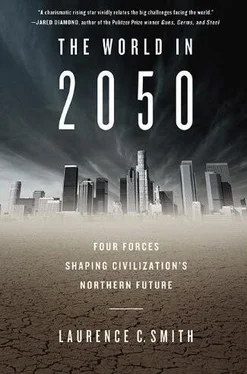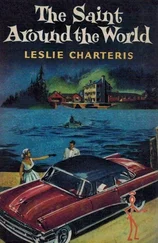Apparently, the physics of greenhouse gas warming is a lot easier to comprehend than the pace of human industrialization. We’ve already raised the concentration of CO 2in the atmosphere nearly 40%, up from ~280 parts per million by volume (ppmv) in preindustrial times to ~387 ppmv as of 2009. Two-thirds of that rise has been carefully documented since 1958, when the first continuous air sample measurement program was begun by Charles Keeling at Hawaii’s Mauna Loa Observatory as part of the International Geophysical Year. Atmospheric measurements of two other powerful greenhouse gases also released by human activity, methane and nitrous oxide levels, have followed a similar rising pattern. Depending on the choices we make about carbon emissions, CO 2projections for century’s end range anywhere from 450 to 1,550 ppmv, corresponding to a +0.6 to +4.0°C increase in average global temperature on top of the +0.7°C increase already experienced in the twentieth century. 38Many policy pragmatists now feel a +2°C increase is all but assured, after the 2009 Copenhagen Climate Conference failed to produce anything resembling a binding international agreement to curb carbon emissions.
These numbers may sound small but they’re not. At the height of the last ice age, when Chicago was buried under a mile-deep sheet of ice, global temperatures averaged just 5°C (9°F) cooler than today. From historical weather-station data the global average temperature is already +0.8°C warmer than in Arrhenius’ time, with most of that rise since the 1970s. An increase of that magnitude is already much larger than the difference between any one year and the next. As expected, this warming trend varies strongly with geography, with even some local cooling in some places (the details and reasons for this are known and discussed further in Chapter 5). But the global average is trending upward, along with the steady measured growth of greenhouse gas concentrations in the atmosphere.
Not only are average temperatures rising, the way they are rising is consistent with the greenhouse effect but inconsistent with other natural cycles and processes also known to influence climate. Temperatures are warming more by night than by day; more in winter than in summer; more over oceans than over land; more at high latitudes than in the tropics; and in the troposphere but not the stratosphere. All of these are consistent with greenhouse gas forcing but inconsistent with other known causes, like urban heat islands, changing solar brightness, volcanic eruptions, and astronomical cycles. Those, too, influence climate, but none can fully explain what we are seeing today.
In addition to number-crunching weather data, there is plenty of anecdotal evidence that our climate is beginning to act strangely. A staggering thirty-five thousand people were killed in 2003 when a massive heat wave spilled across Europe. Lesser waves killed hundreds more in Japan, China, India, and the United States in the following summers, when the world suffered eleven of the top twelve hottest years ever recorded. That’s dating all the way back to the first weather stations of 1850, when Zachary Taylor was president of the United States, and Italy wasn’t even a country yet. Hurricane Katrina drowned New Orleans in 2005, a record year for tropical storms. Ironically, many of the displaced moved to Houston, where they got pounded again by Hurricane Ike in 2008. That one killed about two hundred people and put a tree through the roof of my best man, then proceeded to black out nearly a million homes across Ohio, Indiana, and Kentucky.
Like the pizzly bear, no one of these events is conclusive of anything. But after enough of them happen, the private sector gets moving. Goldman Sachs and the Harvard Business Review started writing reports on how to contain risk and maximize profits from climate change. 39Multinational corporations like General Electric, Duke Energy, and Dupont began stumping green technology and formed the U.S. Climate Action Partnership, calling on the U.S. federal government to “quickly enact strong national legislation to require significant reductions of greenhouse gas emissions.” 40By 2008 its membership included American International Group, Inc. (AIG), Boston Scientific Corporation, Chrysler LLC, ConocoPhillips, Deere & Company, the Dow Chemical Company, Exelon Corporation, Ford Motor Company, General Motors Corporation, Johnson & Johnson, Marsh, Inc., the National Wildlife Federation, the Nature Conservancy, NRG Energy, Inc., PepsiCo, Rio Tinto, Shell, Siemens Corporation, and Xerox Corporation. 41However, by late 2009 the rush of corporations to join the U.S. Climate Action Partnership had slowed, following the failed climate treaty conference at Copenhagen, some dumb e-mails circulated among a clique of climate scientists (the so-called Climategate scandal, a scientifically minor but politically devastating public-relations fiasco), and a moribund cap-and-trade bill in the U.S. Senate. By 2010 ConocoPhillips, BP America, Caterpillar, and Xerox had pulled out.
Gas molecules are impervious to politics, so all of this is really just the beginning. To underscore just how dramatic our run-up of CO 2, methane, and nitrous oxide in the atmosphere is, let’s place it within the much longer context of geological time. Greenhouse gases follow both natural cycles—which fall and rise with ice ages and warm interglacial periods, respectively—and human activity, which proceeds much faster. These two actors operate over totally different time scales, with the ice age variations happening over tens of thousands of years but our human excursion unfolding over tens of years. The natural processes that drive greenhouse-gas shifts—rock weathering, astronomical cycles, the spread of forests or wetlands, ocean turnover, and others—take thousands of years, whereas human excavation and burning of old buried carbon—as illustrated earlier from U.S. history—is an action both massive and brief. And because our human-generated carbon burst is perched atop an already large, slow-moving natural interglacial peak, we are taking the atmosphere to a place the Earth has not seen for hundreds of thousands, perhaps millions, of years. 42
We know this from the ancient memories of glaciers, deep ocean sediments, tree rings, cave speleothems, and other natural archives. Most spectacular are tiny air bubbles trapped within Greenland and Antarctic ice, each a hermetically sealed air sample from the past. Loose air inside a glacier’s surface snowpack gets closed off into bubbles as the weight of still more snowfall fuses it into ice. Annual layers of these bubbles have been quietly laid down for hundreds of thousands of years, before being drilled from the guts of Greenland and Antarctica by a rare breed of scientist. The gas levels inside them prove we have now elevated the concentrations of greenhouse gases in the Earth’s atmosphere higher than they’ve been for at least eight hundred thousand years.
Eight hundred thousand years . Jesus Christ walked barely two thousand years ago, Egypt’s pharaohs four. Our first agricultural civilizations began ten thousand years ago; twenty thousand years before that, there still were Neanderthals alive. But the world has not seen atmospheric CO 2levels like today’s for eight hundred thousand years — and they are now approaching those of fifteen million years ago in the Miocene Epoch, when the world’s temperatures were 3° to 6°C warmer, its oceans acidic, polar ice caps diminished, and sea levels twenty-five to forty meters higher than today. 43
This, too, is a global force to be reckoned with.

These four global forces—demographics, resource demand, globalization, and climate change—will shape our future and are recurring themes throughout this book. As each force comes up, the corresponding icon from the set that headed the four preceding sections will head the discussion. While I have described these forces separately they are, of course, intimately intertwined. Greenhouse gas comes from the exploitation of natural resources, which in turn tracks the global economy, which in turn relates partly to population dynamics, and so on.
Читать дальше













